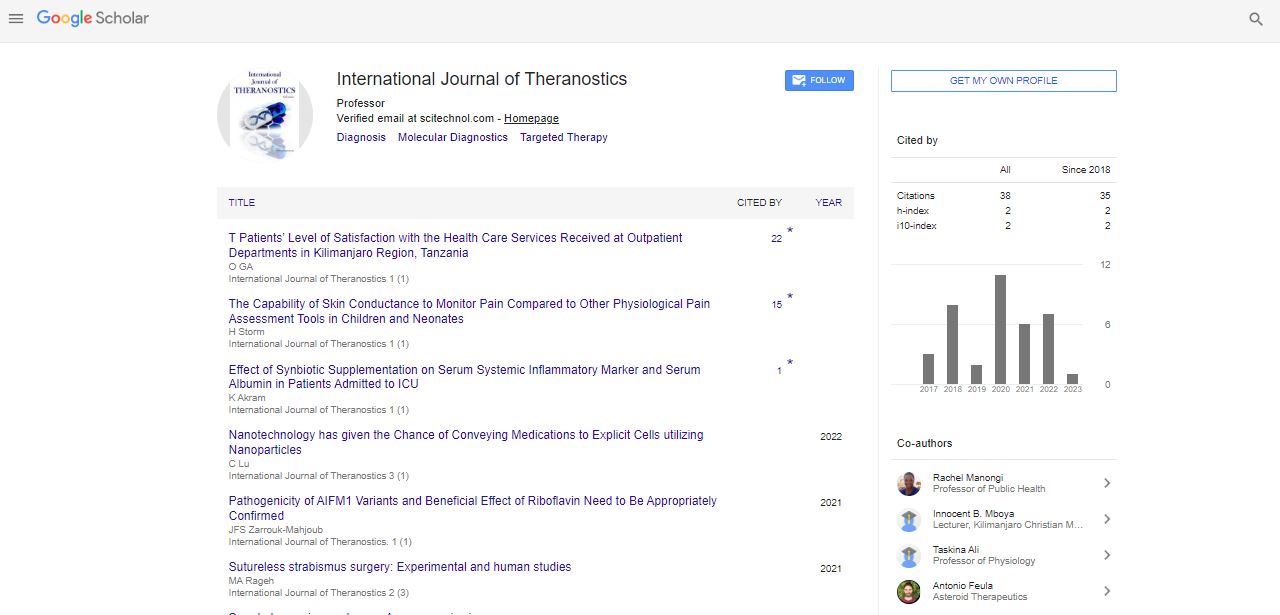Opinion Article, Int J Theranostic Vol: 12 Issue: 4
Decoding Medical Complexity: Bridging Insights through Radiomic and Radiogenomic Integration
Ruhana G. Sharma*
1Department of Pharmaceutics, National Institute of Pharmaceutical Education and Research, Lucknow, India
*Corresponding Author: Ruhana G. Sharma,
Department of Pharmaceutics,
National Institute of Pharmaceutical Education and Research, Lucknow, India
E-mail: Ruhanasdharmag653@gmail.com
Received date: 27 November, 2023, Manuscript No. IJT-23-124058;
Editor assigned date: 29 November, 2023, PreQC No. IJT-23-124058 (PQ);
Reviewed date: 14 December, 2023, QC No. IJT-23-124058;
Revised date: 21 December, 2023, Manuscript No. IJT-23-124058 (R);
Published date: 28 December, 2023, DOI: 10.4172/IJT.1000145.
Citation: Sharma RG (2023) Decoding Medical Complexity: Bridging Insights through Radiomic and Radiogenomic Integration. Int J Theranostic 12:5.
Abstract
Description
The field of medical imaging has undergone a transformative evolution, transcending its traditional role as a mere diagnostic tool. The integration of radiomic and radiogenomic data has emerged as a revolutionary approach, providing a wealth of quantitative information beyond visual assessments. This essay delves into the synergistic integration of radiomic and radiogenomic data, exploring how this convergence enhances the accuracy of diagnosis, refines prognostic predictions, and informs personalized treatment planning.
Radiomics involves the extraction of a multitude of quantitative features from medical images, transcending the conventional visual interpretation. These features include texture, shape, intensity, and spatial relationships within the images. Advanced computational analysis transforms these features into high-dimensional data, creating what is known as a radiomic signature. Radiomics aims to uncover hidden patterns and nuances within medical images that might not be apparent through traditional qualitative assessments.
Radiogenomics complements radiomics by associating the extracted imaging features with underlying genetic and molecular characteristics of the tissues imaged. This integration links imaging phenotypes with genomic alterations, enabling a deeper understanding of the biological basis of observed imaging patterns. Radiogenomic analyses often involve correlating radiomic features with specific genetic mutations, gene expressions, or other molecular markers. This connection enhances the ability to unravel the underlying pathophysiology of diseases.
Integrating radiomic and radiogenomic data has substantially improved cancer diagnosis. In oncology, the heterogeneity of tumors is a critical factor influencing treatment responses. Radiomics allows for the extraction of quantitative features that capture this heterogeneity, aiding in distinguishing between benign and malignant lesions. By linking radiomic features with specific genomic alterations through radiogenomics, clinicians gain insights into the molecular underpinnings of the observed imaging characteristics, facilitating more accurate tumor characterization.
The integration of radiomic and radiogenomic data has shown promise in the diagnosis of neurological disorders. In conditions like gliomas, where genetic mutations significantly impact disease progression, radiogenomic analyses help correlate imaging features with specific genetic alterations. This correlation contributes to more accurate differentiation between tumor grades and aids in predicting patient outcomes.
Radiomic and radiogenomic integration is also valuable in infectious diseases. For instance, in pulmonary infections, radiomic analyses of chest CT scans can reveal subtle patterns that correlate with specific pathogens or inflammatory processes. Understanding the genomic basis of these radiomic patterns enhances the accuracy of diagnosing infectious diseases and guides appropriate treatment strategies.
The integration of radiomic and radiogenomic data has significantly advanced prognostic predictions in cancer. By correlating radiomic features with genomic alterations, researchers and clinicians can identify imaging biomarkers associated with disease aggressiveness and prognosis. This refined prognostication informs treatment decisions, enabling personalized therapeutic interventions based on the predicted trajectory of the disease.
In cardiovascular imaging, the integration of radiomic and radiogenomic data contributes to improved prognostication. By linking imaging features with genetic markers associated with cardiovascular diseases, clinicians can assess the risk of adverse events such as myocardial infarction or stroke. This information guides preventive strategies and helps tailor interventions to individual patient risks. Understanding how tumors respond to treatment is crucial for refining therapeutic strategies. Radiomic and radiogenomic integration provides valuable insights into predicting treatment responses. By correlating changes in imaging features with genetic alterations, clinicians can anticipate how tumors are likely to react to specific therapies. This enables the timely adjustment of treatment plans, maximizing the chances of therapeutic success.
Radiomic and radiogenomic data play a pivotal role in tailoring treatment plans, particularly in the era of targeted therapies. For example, in oncology, identifying specific radiomic signatures associated with certain genetic mutations allows for the selection of targeted therapies that address the molecular drivers of the disease. This personalized approach enhances treatment efficacy while minimizing unnecessary side effects.
In radiation oncology, radiomic data contribute to personalized radiotherapy planning. By analyzing the spatial distribution and heterogeneity of tumors through radiomics, clinicians can optimize the delivery of radiation doses. Radiogenomic insights further refine this process by identifying genetic factors influencing radiosensitivity, allowing for the customization of radiation doses based on the individual's genomic profile.
Radiomic and radiogenomic integration holds promise in predicting responses to immunotherapy. The complex interplay between the tumor microenvironment and the immune system can be elucidated through radiogenomic analyses. This information guides the selection of patients likely to benefit from immunotherapies and aids in monitoring treatment responses. Collaborative efforts across multiple centers and institutions are crucial for validating and generalizing radiomic and radiogenomic findings. Large-scale collaborations facilitate the pooling of diverse datasets, enabling more robust analyses and ensuring the broad applicability of integrated approaches.
The integration of radiomic and radiogenomic data represents a transformative shift in medical imaging, offering a deeper understanding of diseases and guiding more precise clinical decisionmaking. From improved diagnosis and prognostication to personalized treatment planning, the synergy between radiomics and genomics has the potential to redefine the landscape of healthcare. As research continues to unravel the complexities of this integration, the future holds promise for more individualized, effective.
 Spanish
Spanish  Chinese
Chinese  Russian
Russian  German
German  French
French  Japanese
Japanese  Portuguese
Portuguese  Hindi
Hindi 